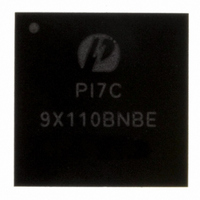PI7C9X110BNBE Pericom Semiconductor, PI7C9X110BNBE Datasheet - Page 21

PI7C9X110BNBE
Manufacturer Part Number
PI7C9X110BNBE
Description
IC PCIE TO PCI REV BRG 160LFBGA
Manufacturer
Pericom Semiconductor
Specifications of PI7C9X110BNBE
Applications
PCI-to-PCI Bridge
Interface
I²C
Voltage - Supply
1.8 V
Package / Case
160-LBGA
Mounting Type
Surface Mount
Operating Temperature (min)
-40C
Operating Temperature Classification
Industrial
Operating Temperature (max)
85C
Rad Hardened
No
Maximum Operating Temperature
+ 85 C
Minimum Operating Temperature
- 40 C
Mounting Style
SMD/SMT
Lead Free Status / RoHS Status
Lead free / RoHS Compliant
Lead Free Status / RoHS Status
Lead free / RoHS Compliant, Compliant
Available stocks
Company
Part Number
Manufacturer
Quantity
Price
Company:
Part Number:
PI7C9X110BNBE
Manufacturer:
PLX
Quantity:
1 238
Company:
Part Number:
PI7C9X110BNBE
Manufacturer:
PERICOM31
Quantity:
193
Part Number:
PI7C9X110BNBE
Manufacturer:
PERICOM
Quantity:
20 000
3
3.1
3.2
4
If TM2 is strapped to low, PI7C9X110 uses TM1, TM0, CFN_L, and REVRSB pins to select different modes of
operations. These four input signals are required to be stable during normal operation. One of the sixteen
combinations of normal operation can be selected by setting the logic values for the four mode select pins. For
example, if the logic values are low for all four (TM1, TM0, CFN_L, and REVRSB) pins, the normal operation will
have EEPROM (I2C) support in transparent mode with internal arbiter in forward bridge mode. The designated
operation with respect to the values of the TM1, TM0, CFN_L, and REVRSB pins are defined on Table 3-1:
Table 3-1 Mode Selection
If TM2 is strapped to high, PI7C9X110 uses TM1, TM0, and MSK_IN as strapping pins. The strapping functions
are listed in Table 3-2 to show the states of operations during the PCI Express PERST_L de-assertion transition in
forward bridge mode or PCI RESET_L de-assertion transition in reverse bridge mode.
Table 3-2 Pin Strapping
PI7C9X110 supports forward or reverse and transparent or non-transparent combination modes of operation. For
example, when PI7C9X110 is operating in forward (REVRSB=0) and non-transparent bridge mode (TM0=1) shown
in Figure 4-1, its PCI Express interface is connected to a root complex and its PCI bus interface is connected to PCI
devices. Another example, PI7C9X110 can be configured as a reverse (REVRSB=1) and transparent (TM0=0)
bridge shown in Figure 4-2.
Pericom Semiconductor – Confidential
MODE SELECTION AND PIN STRAPPING
FUNCTIONAL MODE SELECTION
PIN STRAPPING
FORWARD AND REVERSE BRIDGING
TM2 Strapped
TM2 Strapped
0
0
0
0
0
0
0
0
1
1
1
1
1
1
1
1
TM1 Strapped
TM1
X
X
X
X
X
X
0
1
0
0
1
1
0
0
1
1
TM0
X
X
X
X
X
X
0
1
TM0 Strapped
Page 21 of 144
0
1
0
1
0
1
0
1
CFN_L
X
X
X
X
X
X
0
1
MSK_IN Strapped
1
1
1
1
0
0
0
0
REVRSB
X
X
X
X
X
X
0
1
Test Functions
PLL test
Shorten initialization test with hot-
plug enabled
Functional loopback test
Bridge test (PRBS, IDDQ, etc.)
Reserved
Shorten initialization test with hot-
plug disabled
Reserved
Reserved
April 2010, Revision 3.0
EEPROM (I2C) support
SM Bus support
Transparent mode
Non-Transparent mode
Internal arbiter
External arbiter
Forward bridge mode
Reverse bridge mode
PCIe-to-PCI Reversible Bridge
Functional Mode
PI7C9X110











